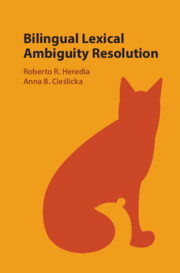Book contents
- Bilingual Lexical Ambiguity Resolution
- Bilingual Lexical Ambiguity Resolution
- Copyright page
- Dedication
- Contents
- Figures
- Tables
- Contributors
- Preface
- Acknowledgments
- Part I Theoretical and Methodological Considerations
- Part II Bilingual Lexical Processing
- Part III Bilingual Sentence Processing
- Part IV Neuroscience of Bilingual Lexical Access
- Author Index
- Subject Index
- References
Part III - Bilingual Sentence Processing
Published online by Cambridge University Press: 24 December 2019
- Bilingual Lexical Ambiguity Resolution
- Bilingual Lexical Ambiguity Resolution
- Copyright page
- Dedication
- Contents
- Figures
- Tables
- Contributors
- Preface
- Acknowledgments
- Part I Theoretical and Methodological Considerations
- Part II Bilingual Lexical Processing
- Part III Bilingual Sentence Processing
- Part IV Neuroscience of Bilingual Lexical Access
- Author Index
- Subject Index
- References
Summary

- Type
- Chapter
- Information
- Bilingual Lexical Ambiguity Resolution , pp. 157 - 228Publisher: Cambridge University PressPrint publication year: 2020



